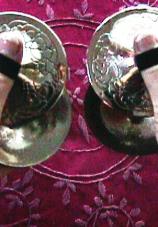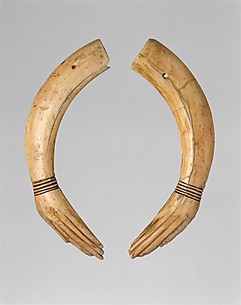About Zills
Wooden clappers have been around since the earliest civilizations
appearing around 3000 BCE in ancient Egyptian imagery. They were often
shaped as an actual pair of arms and hands and by 2000 BCE they were
being made out of wood, bone, and ivory. Not far away in Mesopotamia
similar clappers were being made and were even made out of copper.
These early percussion instruments were usually associated with magic and
ritual. In Egypt they were heavily associated with the Goddess Hathor.
Similar hand held percussive clappers have been a part of rituals and music
in many cultures around the region. The ancient Romans and Greeks were
quite fond of them as well and they were often associated with the rituals
and dances of those in Dyonisic cults.
Amazigh (Berber) tribes use clappers in their music and dance practices
utilizing what is referred to as a Karkaba or Qarkabeb which is like a large
set of cymbals attached together by a handle. These are generally made of
metal but like many similar instruments in the region may have started out as
bone, ivory, or wood.
Flamenco which developed from the cultural mix of Spanish folk music, North African Moorish music, classical Arabic music, and Romani music of Al-Andalus near the end of the Islamic Andalusi period (late 1400s - early 1500s) utilizes wooden clappers called castanets. These are two cupped halves that are strung together at one end. The strings are placed around the thumb tight enough to create tension that holds the castanets open. The rest of the fingers can then be utilized to tap against the top castanet while the bottom rests against the palm holding it still. Because this allows four fingers to individually or collectively close the castanet it can produce fast paced complex rhythms.
Medieval Turkish and Greek musicians and dancers used wooden spoons. Each hand has a pair of spoons. One spoon is placed against the palm with the curved bottom facing out. The handle of the spoon between the thumb and forefinger. The thumb can apply pressure against the handle while the pinky (and depending on the person sometimes also the index finger) hold the cupped end against the palm. Then the other spoon is placed with it's curved bottom against the back of the first spoon with it's handle between the forefinger and middle finger which can then fold down gripping the spoon and resting nicely in it's curve. This allows the player to tap the top spoon against the bottom creating the rhythmic pattern. Wooden spoons remain a popular instrument in both Greece and Turkey today for folk music and dance.
In India Manjira have long been used in dance performances sometimes tied to fingers and clapped together but often they are tied together by a longer string and then clapped together holding one in each hand if larger or other times the smaller ones are swung around to strike other cymbals that have been tied to various parts of the body. This makes for an interesting visual presentation as well as music.
The Ghawazee of Egypt are known for playing finger cymbals (Sagat) and their metal cymbals are the one holed type that requires being held in a unique way using a "crab-like" grip as some dancers describe it. The single hole means the tie cannot fasten them as steady to the fingers so they can roll around while playing. This type of cymbal also has been depicted as in use since at least the Medieval era.
Large metal cymbals became commonly used in Turkish Ottoman military bands but smaller ones developed similar to the Egyptian Sagat. The modern styles have 2 slots which allow a ribbon or in most cases a flat, non-roll elastic to be sewn or tied to hold the cymbals steady on the fingers. this gives more control over the movement of the cymbals.
There are many various sizes, qualities, and sounds for finger cymbals. The size of the zills will determine it's pitch and tone. If you have a small set of zills they will probably be high pitched and the sound will travel only short distances. Medium sized zills will have a lower pitch than small zills and the sound will travel further than small zills. Large sized zills will have a much lower pitch and their sound will travel much further. As such Large zills are usually best for loud restaurants where they easily travel over voices, large stages where the sound must travel to the back of the auditorium, or outdoors where the sound can carry over crowds and wind. Small zills are usually best for a) small hands and b) practicing (nothing like waking up your neighbors to the loud sounds of zills at night, they really appreciate it... don't they?). and of course c) small areas such as doing a bellygram at an office where you don't want to distract every department in the building.
Other things to look for when your looking for zills is the type of holes they have. Generally, finger cymbals have two types of holes; singular circular holes and two slot holes. The one holers tend to be cheaper but, they are often harder to work with since they like to roll around on your fingers unless you master the right hold. The two slot zills tend to stay in place better but cost more. They tend to produce different tonal qualities too. The one-holers will produce a more clanky sound while two-slotters can produce a clearer crisper ringing tone. If your into authentic Egyptian dance you might want to consider using the traditional one-hole Sagat and mastering the special hold if your more into other styles like American Nightclub/Cabaret or Turkish you may want to consider picking the two-slot zills. They also come on more sizes, designs, and qualities which can provide you with better practice and performance options.
Here are some different types and styles of "clappers" and cymbals you may see used in Middle Eastern and fusion inspired dances:
When your practicing at home and you don't want to disturb others with the noise (especially important for people in apartments) you can use zill mufflers. You can purchase zill mufflers at various Internet sites or you can easily make your own. You can make them either by cutting off the toes of old socks and sewing elastic around the edge so they fit snuggly around the zill or you can cut out a piece of fabric that is slightly bigger then the circumference of the zills and then attach the elastic to the edge of the fabric and make sure it fits snuggly around the zill. Additionally some people like to crochet a set of zill mufflers which can look nicer than sock toes or fabric mufflers. Of course another quieter option for practicing your zilling is simply snapping out the patterns. It builds the same muscles and flexibility and allows the repetition of patterns so they still get into the muscle memory but you can do it anywhere with out even having your zills.
Zills usually are played in addition to music as an accent by the dancer (or by a professional zill player performing live music with the band) but they can be used independantly without music to accompany a dancer as well. While these kind of solos are rare they demonstrate the skill of a dancer and is a great backup plan in case your music ever cuts out or something. This is a nice zill solo performance by Amina Salah.
If your interested buying a pair of zills (or sagat) or other "clappers" here are some of the recommended sites:
Ziljidan (they offer several sets of Zills in their fx series)
Saroyan (arguably the best dancers zills with many different size and decorative patterns)
Nearly any bellydance vendor will sell zills (sometimes ones from the above sites) and there are other manufacturers and sites out there but these are among the better quality and highly recommend by dancers.




